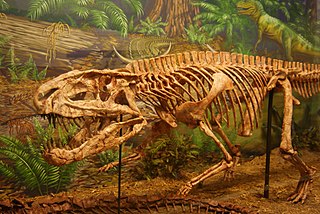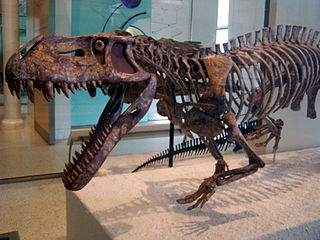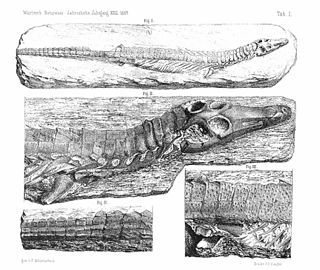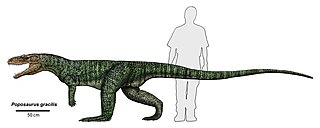
"Rauisuchia" is a paraphyletic group of mostly large and carnivorous Triassic archosaurs. Rauisuchians are a category of archosaurs within a larger group called Pseudosuchia, which encompasses all archosaurs more closely related to crocodilians than to birds and other dinosaurs. First named in the 1940s, Rauisuchia was a name exclusive to Triassic archosaurs which were generally large, carnivorous, and quadrupedal with a pillar-erect hip posture, though exceptions exist for all of these traits. Rauisuchians, as a traditional taxonomic group, were considered distinct from other Triassic archosaur groups such as early dinosaurs, phytosaurs, aetosaurs, and crocodylomorphs.
Phytosaurs are an extinct group of large, mostly semiaquatic Late Triassic archosauriform reptiles. Phytosaurs belong to the order Phytosauria. and are sometimes referred to as parasuchians. Phytosauria, Parasuchia, Parasuchidae, and Phytosauridae have often been considered equivalent groupings containing the same species. Some recent studies have offered a more nuanced approach, defining Parasuchidae and Phytosauridae as nested clades within Phytosauria as a whole. Phytosaurs were long-snouted and heavily armoured, bearing a remarkable resemblance to modern crocodilians in size, appearance, and lifestyle, as an example of convergence or parallel evolution

Procompsognathus is an extinct genus of coelophysid theropod dinosaur that lived approximately 210 million years ago during the later part of the Triassic Period, in what is now Germany. Procompsognathus was a small-sized, lightly built, ground-dwelling, bipedal carnivore, that could grow up to 1 m (3.3 ft) long.
Halticosaurus (pron.:"HAL-tick-oh-SORE-us") is a dubious genus of theropod dinosaur from the late Triassic period. It is known from a single fragmentary fossil specimen of the species H. longotarsus, found in the Middle Stubensandstein formation of what is present-day Germany The only known specimen was poorly preserved and may have been put together from bones of unrelated animals. Further research would be required to determine which of the bones belonged together, and what kind of theropod Halticosaurus was. However, most of the bones have been lost. For these reasons, Halticosaurus is considered to be a nomen dubium.

Teratosaurus is a genus of rauisuchians known from the Triassic Stubensandstein of Germany. It is estimated to be 6.2 meters (20.35 ft) long.
Spinosuchus is an extinct genus of trilophosaurid allokotosaur from the Late Triassic of Texas, southern United States. It has been assigned to a variety of groups over its history, from coelophysid dinosaur to pseudosuchian to uncertain theropod dinosaur and to Proterosuchidae. This uncertainty is not unusual, given that it was only known from a poorly preserved, wall-mounted, partial vertebral column of an animal that lived in a time of diverse, poorly known reptile groups. However, newly collected material and recent phylogenetic studies of early archosauromorphs suggest that it represents an advanced trilophosaurid very closely related to Trilophosaurus.

Pseudosuchia is one of two major divisions of Archosauria, including living crocodilians and all archosaurs more closely related to crocodilians than to birds. Pseudosuchians are also informally known as "crocodilian-line archosaurs". Despite Pseudosuchia meaning "false crocodiles", the name is a misnomer as true crocodilians are now defined as a subset of the group.

Rauisuchidae is a group of large predatory Triassic archosaurs. Some disagreement exists over which genera should be included in the Rauisuchidae and which should be in the related Prestosuchidae and Poposauridae, and indeed whether these should even be thought of as separate valid families. Rauisuchids occurred throughout much of the Triassic, and may have first occurred in the Early Triassic if some archosaurian taxa such as Scythosuchus and Tsylmosuchus are considered to be within the family.

Prestosuchidae is a polyphyletic grouping of carnivorous archosaurs that lived during the Triassic. They were large active terrestrial apex predators, ranging from around 2.5 to 7 metres in length. They succeeded the Erythrosuchidae as the largest archosaurs of their time. While resembling erythrosuchids in size and some features of the skull and skeleton, they were more advanced in their erect posture and crocodile-like ankle, indicating more efficient gait. "Prestosuchids" flourished throughout the whole of the middle, and the early part of the late Triassic, and fossils are so far known from Europe, India, Africa (Tanzania), Argentina, and Paleorrota in Brazil. However, for a long time experts disagree regarding the phylogenetic relationships of the group, what genera should be included, and whether indeed the "Prestosuchidae" constitute a distinct family.

Terrestrisuchus is an extinct genus of very small early crocodylomorph that was about 76 centimetres (30 in) long. Fossils have been found in Wales and Southern England and date from near the very end of the Late Triassic during the Rhaetian, and it is known by type and only known species T. gracilis. Terrestrisuchus was a long-legged, active predator that lived entirely on land, unlike modern crocodilians. It inhabited a chain of tropical, low-lying islands that made up southern Britain, along with similarly small-sized dinosaurs and abundant rhynchocephalians. Numerous fossils of Terrestrisuchus are known from fissures in limestone karst which made up the islands it lived on, which formed caverns and sinkholes that preserved the remains of Terrestrisuchus and other island-living reptiles.

Batrachotomus is a genus of prehistoric archosaur. Fossils of this animal have been found in southern Germany and dated from the Ladinian stage of the Middle Triassic period, around 242 to 237 million years ago. Batrachotomus was described by palaeontologist David J. Gower 22 years after its discovery.
The Löwenstein Formation is a lithostratigraphic formation of the Keuper in Germany. It is underlain by the Mainhardt Formation and overlain by the Trossingen Formation. It dates back to the middle Norian.

Dyoplax is an extinct genus of pseudosuchian archosaur, possibly an erpetosuchid. Fossils have been found from the type locality within the upper Schilfsandstein Formation in Stuttgart, Germany. The holotype specimen was a natural cast of a nearly complete skeleton that lacked only parts of the tail and limb bones.

Heptasuchus is an extinct genus of loricatan pseudosuchian known from the Middle or Late Triassic upper Chugwater Group of Wyoming, United States. It contains a single species, Heptasuchus clarki, the first formally recognized "rauisuchian" or loricatan pseudosuchian from North America.
Procerosuchus is an extinct genus of loricatan archosaur. Fossils have been collected from the Late Triassic Santa Maria Formation in Geopark of Paleorrota, Rio Grande do Sul, Brazil, which is Carnian in age. The genus was first described by the German paleontologist Friedrich von Huene in 1942.

Suchia is a clade of archosaurs containing the majority of pseudosuchians. It was defined as the least inclusive clade containing Aetosaurus ferratus, Rauisuchus tiradentes, Prestosuchus chiniquensis, and Crocodylus niloticus by Nesbitt (2011). Generally the only pseudosuchian group which is omitted from Suchia is the family Ornithosuchidae, although at least one analysis classifies ornithosuchids as close relatives of erpetosuchids and aetosaurs. Phytosaurs are also excluded from Suchia, although it is not certain whether they qualify as pseudosuchians in the first place.

Loricata is a clade of archosaur reptiles that includes crocodilians and some of their Triassic relatives, such as Postosuchus and Prestosuchus. More specifically, Loricata includes Crocodylomorpha and most "rauisuchians", a paraphyletic grade of large terrestrial pseudosuchians which were alive in the Triassic period and ancestral to crocodylomorphs.

Poposauroidea is a clade of advanced pseudosuchians. It includes poposaurids, shuvosaurids, ctenosauriscids, and other unusual pseudosuchians such as Qianosuchus and Lotosaurus. It excludes most large predatory quadrupedal "rauisuchians" such as rauisuchids and "prestosuchids". Those reptiles are now allied with crocodylomorphs in a clade known as Loricata, which is the sister taxon to the poposauroids in the clade Paracrocodylomorpha. Although it was first formally defined in 2007, the name "Poposauroidea" has been used for many years. The group has been referred to as Poposauridae by some authors, although this name is often used more narrowly to refer to the family that includes Poposaurus and its close relatives.

The Röt Formation or Rötton Formation, or Upper Buntsandstein, is a geologic formation of the Buntsandstein in Germany. It preserves fossils dating back to the Middle Triassic Epoch. The formation overlies the Plattenstein and Solling Formations and is overlain by the Jena Formation.
Etjosuchus is an extinct genus of "rauisuchian" (loricatan) archosaur from the Triassic of Namibia. It is known from a single species, Etjosuchus recurvidens, which is based on a partial skeleton from the Ladinian or Carnian-age Omingonde Formation.














